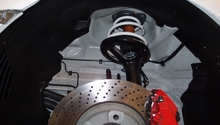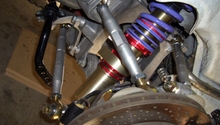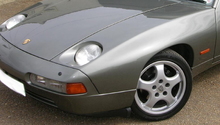Porsche 993: Why is My Suspension Bouncy?
If your Porsche 993 isn't riding quite like it used to, it's probably time for some maintenance. Follow these steps to find the source of the problem.
This article applies to the Porsche 993 (1993-1998).
Over years of driving and hundreds of miles, Porsche 993s hold up quite well, especially when compared to the competition from their day. Not every component can last forever though, and the "weak link" in the 993 has proven to be the suspension. If you are going to have a weak link, that's about the best one to have, as it's easy and cost-effective to replace, and many owners take it as an opportunity for an upgrade.

Materials Needed
- Jack and jack stands
- Flashlight
- Lug wrench
Step 1 – Check the odometer
This is about as easy as it gets. How many miles are on your car? Have the shocks ever been changed? The original Monroe shocks are notorious for conking out with as few as 30,000 miles on the clock. If your car has more than that, and many have significantly more, it's a good idea to change the shocks out on principal. No reason to prematurely wear out your tires and upset the handling and comfort of the car just to eek a few more miles out of a set of dead shocks.

Step 2 – Bounce test
This one is just as easy but takes a bit of finesse. While the car is parked, choose a corner of the car to begin with. Push down hard on the body to compress the suspension and release as soon as it's gone down as far as it will go. Right as it's about to rebound all the way, push down hard again...and again...and again. The goal is to bounce the car with the natural frequency of the spring. Once you have a good amount of motion happening, let go and watch what the car does. With properly functioning shocks, the car should spring back up and settle almost immediately. With blown out shocks, it will oscillate up and down a few times before settling. Do this on all four corners of the car.

Step 3 – Inspect for leaks
Sometimes when shocks wear out, they begin to leak their oil visibly down the body.
Jack the car up and secure it on stands. Take off the wheels to get a better view and take a close look at the shocks, especially where the shaft meets the body. If there is oil residue, the shock is blown out and needs to be replaced. While you are in there, it's a good idea to closely inspect the bushings for tears or cracks. You can't quite set your watch to their failure like you can with the 993 shocks, but if they go bad they can cause handling and ride issues.
(Related Article: Porsche 993: How to Jack up Your Car - Rennlist.com)

Related Discussion
- Car Feels Bouncy, Shocks Toasted - Rennlist.com






